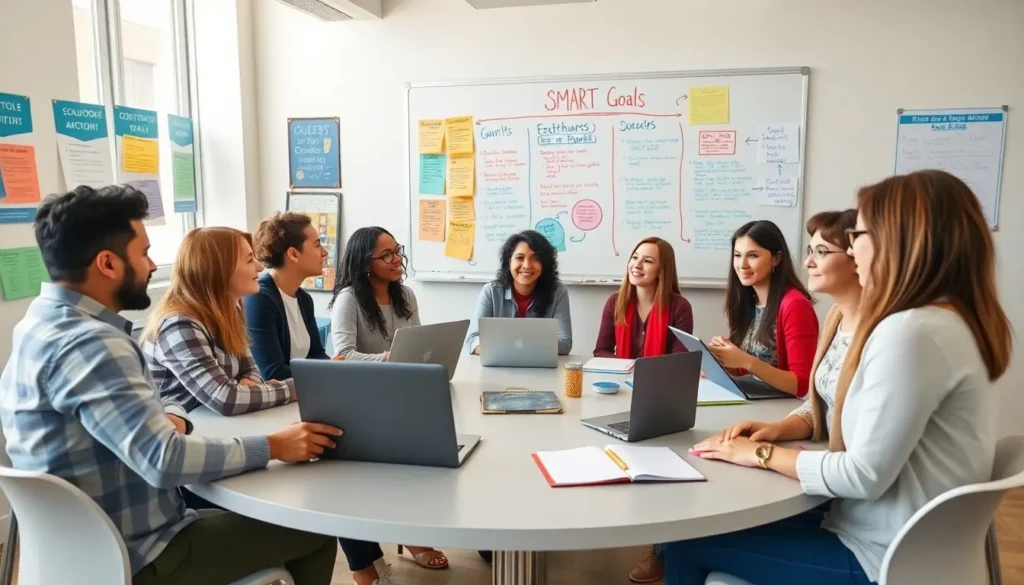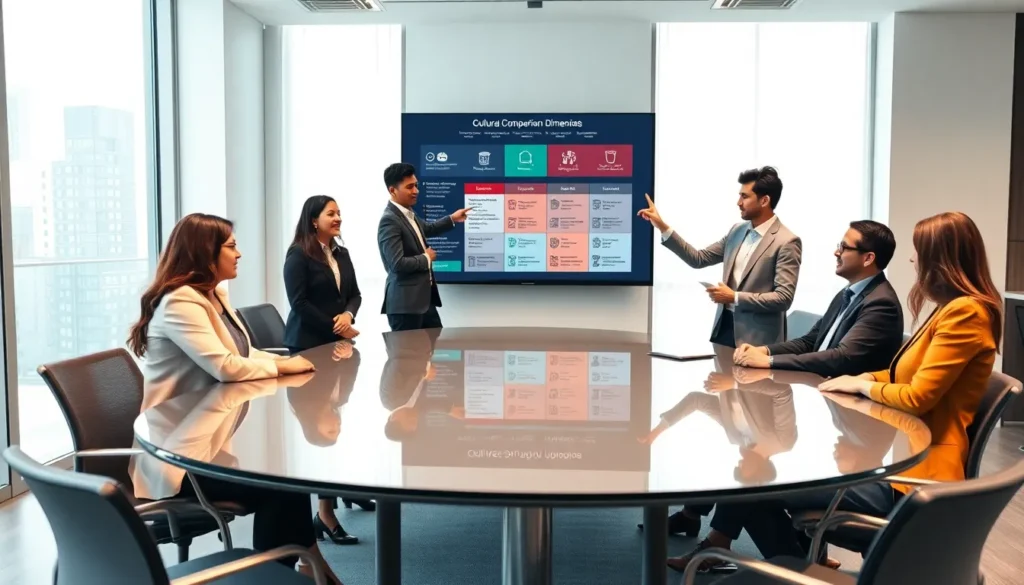In today’s globalized world, cultural competence training isn’t just a nice-to-have; it’s a must-have. Imagine navigating a diverse workplace like a pro, where misunderstandings are as rare as a unicorn sighting. This training equips individuals with the skills to communicate effectively across cultures, making every interaction smoother than a buttered slide.
Table of Contents
ToggleOverview of Cultural Competence Training
Cultural competence training equips individuals with essential skills to interact effectively in diverse environments. It fosters awareness of one’s biases and stereotypes, promoting introspection and growth. Participants engage in experiential learning, often through role-playing and simulations, which enhances empathy and understanding.
Training programs encompass various topics, including communication styles and conflict resolution strategies. Effective training emphasizes the significance of active listening and adaptability while navigating cultural differences. Participants learn to recognize the impact of cultural values on behavior, decision-making, and team dynamics.
Cultural competence benefits organizations by nurturing inclusive workplaces. This inclusion leads to increased employee satisfaction and productivity. Companies often see enhanced creativity due to diverse perspectives contributing to problem-solving.
Specific training modules target aspects such as cross-cultural communication, implicit bias, and the historical context of different cultures. Organizations can choose to customize programs based on their workforce’s needs and goals. Online resources and workshops offer flexibility and accessibility for participants.
Statistics indicate that effective cultural competence training can reduce workplace conflicts by up to 40%. Engaging in this training not only improves interpersonal relations but also builds a stronger overall organizational culture. Employees emerge more equipped to address challenges and collaborate effectively across cultural boundaries.
Importance of Cultural Competence
Cultural competence training plays a pivotal role in fostering effective interactions in today’s diverse environments, ensuring considerations for varied cultural backgrounds. This training encourages growth and understanding, making it essential for individuals and organizations alike.
Benefits for Individuals
Individuals gain invaluable skills through cultural competence training. Enhanced communication skills lead to improved interactions with colleagues from different backgrounds. Empathy development allows for better understanding of diverse perspectives, reducing misunderstandings. Increased self-awareness emerges as participants reflect on their biases, fostering personal growth. Exposure to experiential activities, like simulations, teaches adaptability and resilience when faced with cultural differences. Equipped with these tools, individuals navigate complex workplace dynamics more comfortably and confidently. Statistics reveal that cultural competence enhances job satisfaction and engagement, making training beneficial for professional development.
Benefits for Organizations
Organizations reap significant advantages from cultural competence training. Inclusive workplaces foster creativity, drawing from diverse perspectives to enhance problem-solving capabilities. Employee satisfaction typically increases, leading to higher retention rates and reduced turnover costs. Conflict resolution improves as teams become adept at recognizing and addressing cultural misunderstandings. Implementing customized training modules allows organizations to align programs with specific workforce needs. Enhanced organizational culture results directly from effective training, contributing to overall productivity. Statistics indicate that organizations with trained employees experience a 40% reduction in workplace conflicts, emphasizing the importance of addressing cultural competence systematically.
Key Components of Cultural Competence Training
Cultural competence training comprises several essential components that equip individuals with the skills needed to thrive in diverse environments.
Awareness of Personal Biases
Awareness of personal biases plays a crucial role in cultural competence. Participants reflect on their own thoughts and attitudes, recognizing how these biases impact interactions. By engaging in self-assessment exercises, individuals identify areas for growth. Awareness fosters empathy towards others’ experiences. Training encourages open discussions about biases, which can lead to personal transformation. Individuals often realize the importance of examining stereotypes that may influence their perceptions. Assessing one’s biases helps create a more inclusive atmosphere within organizations. Understanding this connection between personal bias and professional conduct enhances overall effectiveness in diverse settings.
Understanding Cultural Differences
Understanding cultural differences is vital for effective communication. Participants learn to recognize various cultural norms and values, which differ significantly across communities. Training sessions often incorporate case studies that showcase these differences in action. Exploring communication styles provides insight into how different cultures convey messages. Awareness of nonverbal cues enriches interactions, as these cues can vary widely among cultures. Individuals also gain knowledge of cultural practices and traditions that influence workplace dynamics. Emphasis on adaptability prepares participants to navigate conflicts arising from misunderstandings. Cultivating this understanding ultimately leads to more harmonious relationships in diverse teams.
Effective Training Methods
Cultural competence training utilizes various effective methods to enhance learning and understanding. Engaging in diverse training formats ensures comprehensive skill development.
Interactive Workshops
Interactive workshops engage participants through hands-on activities, enabling them to practice new skills in real-time. Role-playing scenarios simulate real-world situations, providing opportunities to navigate cultural differences. Activities encourage collaboration, fostering deeper connections among participants. Group discussions allow individuals to share experiences and reflect, leading to increased empathy and awareness. Feedback from peers promotes constructive learning and reinforces key concepts. Such workshops develop an understanding of cultural nuances and improve communication strategies, equipping individuals with practical tools to apply in their workplaces.
Online Training Modules
Online training modules offer flexibility and accessibility for individuals to learn at their own pace. Users can explore diverse topics through multimedia resources, including videos, quizzes, and interactive content. Self-paced learning caters to varying schedules, ensuring that participants can engage fully in their training. These modules often include assessments to track progress and reinforce learning objectives. Integration of real-world case studies enables learners to confront challenges related to cultural competence directly. Ultimately, online training fosters continuous development and supports the cultivation of a culturally competent workforce.
Challenges in Implementing Cultural Competence Training
Resistance from employees often hinders the implementation of cultural competence training. Many individuals may view such training as unnecessary or feel threatened by discussions surrounding their biases. Creating buy-in is crucial for the success of these programs.
Funding poses another significant challenge. Organizations may struggle to allocate adequate resources for training, resulting in insufficient programs that fail to yield desired outcomes. High-quality training requires investment in both time and financial support.
Measurement of effectiveness presents complexities as well. Tracking progress and outcomes can be difficult, making it challenging to evaluate the impact of cultural competence training. Without clear metrics, organizations may find it hard to justify continued investment in these programs.
Additionally, facilitators face the challenge of addressing varying levels of prior knowledge among participants. Different backgrounds lead to differing comfort levels with discussing sensitive subjects. Tailoring training to accommodate these discrepancies is necessary for an inclusive learning environment.
Time constraints often prevent employees from fully engaging in training. Busy schedules may limit participation, causing individuals to miss out on essential learning experiences. Flexible scheduling or integrating training into regular work hours can help alleviate this issue.
Cultural misunderstandings can also emerge during training. Facilitators must navigate discussions delicately to ensure that all participants feel comfortable sharing their perspectives. Creating a safe space encourages open dialogue and minimizes the risk of offending anyone during discussions.
Finally, lack of long-term commitment from organizations may undermine training efforts. Sustained support and follow-up initiatives reinforce learning. When organizations commit to ongoing development, participants benefit from continued growth in cultural competence.
Cultural competence training is a vital investment for both individuals and organizations. It fosters a more inclusive environment where diverse perspectives thrive. By enhancing communication and empathy skills, participants become more adept at navigating cultural differences.
Organizations benefit from increased employee satisfaction and creativity, leading to improved problem-solving capabilities. The emphasis on continuous development and tailored training programs ensures that cultural competence remains a priority.
As workplaces become increasingly diverse, the commitment to cultural competence training is essential for fostering collaboration and reducing conflicts. Embracing this training not only enhances personal growth but also contributes to a more harmonious and productive workplace culture.









